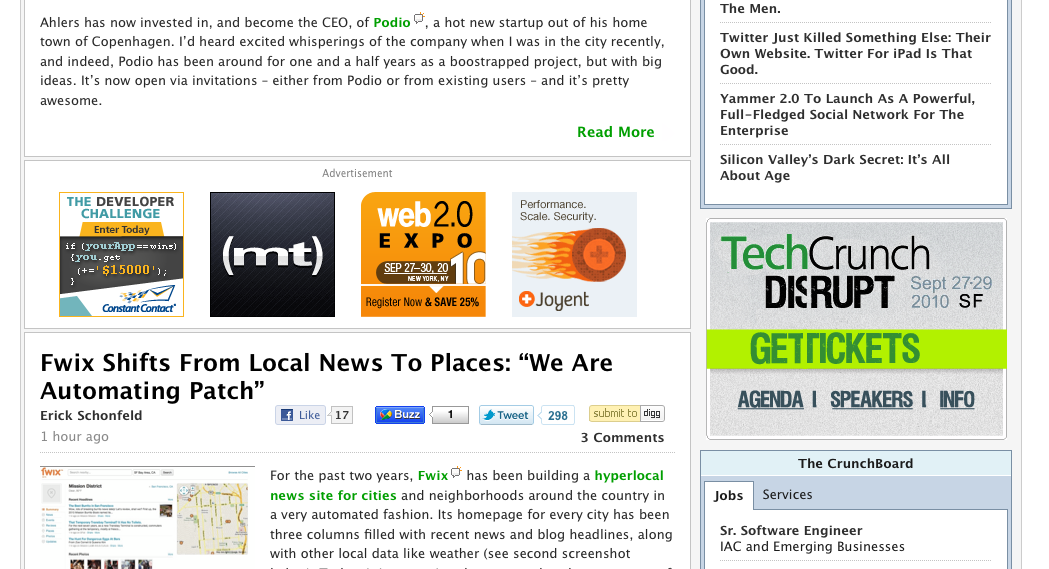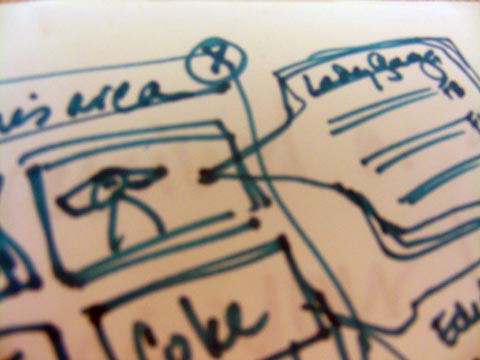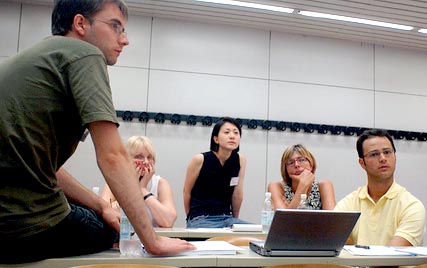Category: Design Process
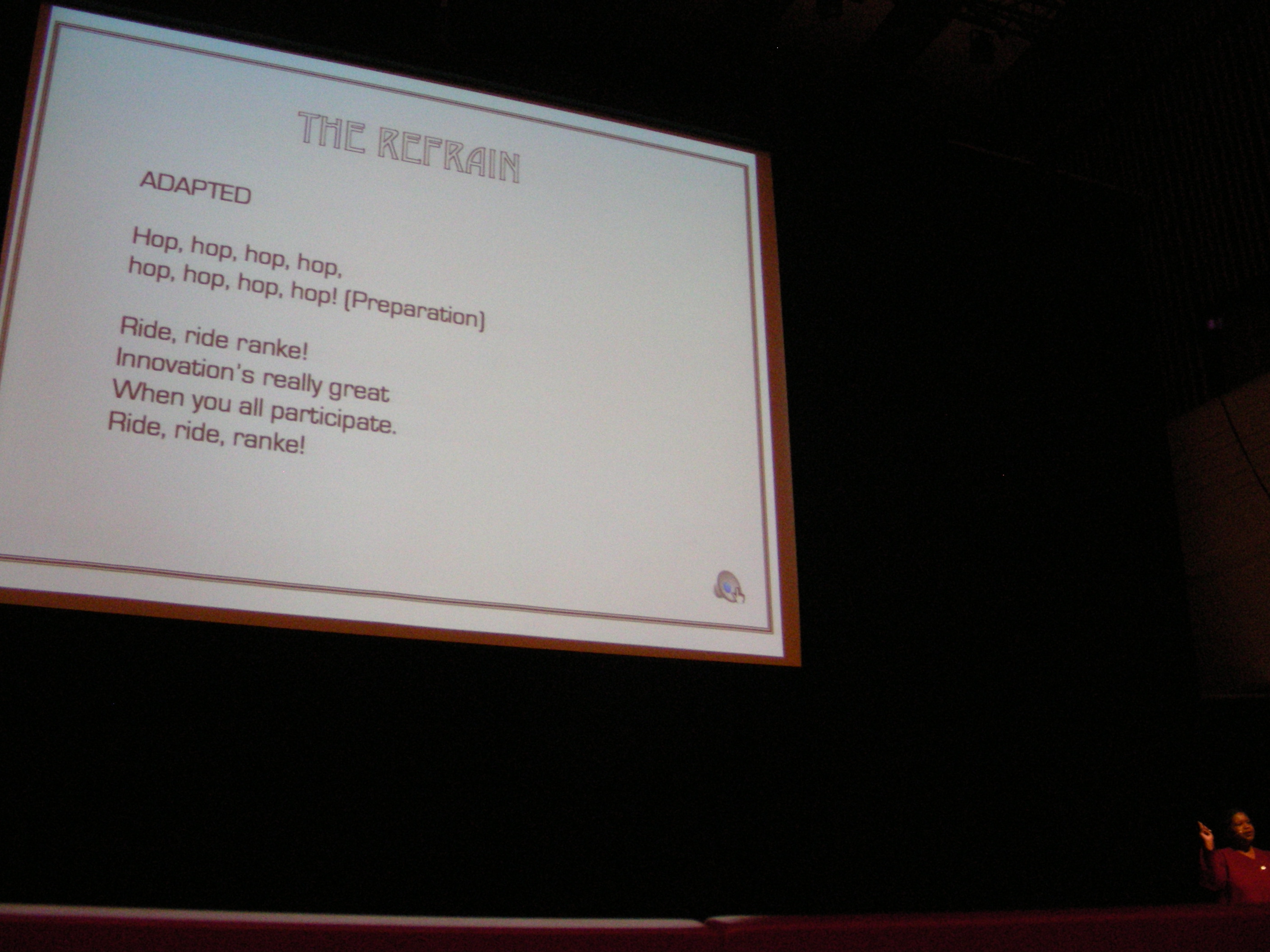 I had the pleasure of attending the Participatory Innovation Conference (PINC) at the University of Southern Denmark on January 12, 2011. Dori Tunstall gave a remarkable closing keynote in which she performed a demonstration of three phases that design research/design anthropology/participatory design/user-centered design have evolved through in the past few decades. It was helpful to have her perspective on the key transitions:
I had the pleasure of attending the Participatory Innovation Conference (PINC) at the University of Southern Denmark on January 12, 2011. Dori Tunstall gave a remarkable closing keynote in which she performed a demonstration of three phases that design research/design anthropology/participatory design/user-centered design have evolved through in the past few decades. It was helpful to have her perspective on the key transitions:
– In the beginning, design anthropology was about researchers as interpretive experts, delivering and recommendations to design teams and others.
– In the 1990s this evolved toward Participatory Design in which interdisciplinary teams participated in observations and defining insights. Insights are delivered in the form of experience models and personas. Researchers become facilitators with multiple, complex stakeholders involved.
– She proposes that the next phase of Design Anthropology will establish the academic foundation of this practice. With that will come a focus on social issues and an understanding of how objects affect the people around them. Designs are disruptions to the people in a culture and those disruptions should be studied. This study of objects and processes define what it means to be human. Design can seek to close the gap between the disruption and the ideal experience.
Dori is now establishing a program at Swinburn University in Melbourne, Australia. It seems to be a program that comes closest to the practice of Design Research as it has developed in the U.S., because of the focus on developing expertise and understanding around studying people and the objects and processes that they use.
From the website:
The purpose of the Master of Design (Design Anthropology) program is threefold:
She recommended some resources that help define this most recent stage of Design Anthropology, and her own work:
- Thinking of Things by Esther Pasztory (2005)
- Collective Joy by Barbara Ehrenreich (2007)
- Transmodernity by Rasa Maria Magda (2004)
- Linda Tuhivai Smith’s (1999) critique of how we conduct research in cultures
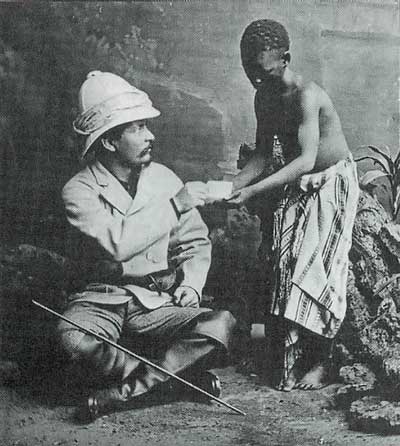 Many conferences have been conducted on this topic. Well, not directly (that would probably be more helpful). But Anthropologists do enjoy centering discourse around who should and should not be conducting research. I have since forgiven EPIC for the first Ethnography in Praxis Conference during which a near fist-fight that broke out over who “owns” ethnography. And EPIC has been much more welcoming toward design researchers since. But what EXACTLY are they defending? It’s very difficult to know what you don’t know. So us “outsiders” are often still in the dark. But the truth is, we can learn a great deal from the ethical and bias-lessening techniques of Anthropologists and Psychologists.
Many conferences have been conducted on this topic. Well, not directly (that would probably be more helpful). But Anthropologists do enjoy centering discourse around who should and should not be conducting research. I have since forgiven EPIC for the first Ethnography in Praxis Conference during which a near fist-fight that broke out over who “owns” ethnography. And EPIC has been much more welcoming toward design researchers since. But what EXACTLY are they defending? It’s very difficult to know what you don’t know. So us “outsiders” are often still in the dark. But the truth is, we can learn a great deal from the ethical and bias-lessening techniques of Anthropologists and Psychologists.
Many universities offer Psychology 101, and I think all Design students should take this, but few offer Anthropology 101. As a result, the fundamentals of Anthropolgy and Cultural studies have eluded me for the first 10 years of my career as a design researcher.
Last week, literally while in the middle of an ethnographic observation, I stumbled upon a book that helped tremendously. I was observing a college student, and during her two-hour homework session in the library, I needed something to occupy my attention, to remove some of it from the back of her head. I wandered over to the Education section (because it was fairly close) and found a book by Rebeka Nathan, “My Freshman Year: What a Professor Learned by Becoming a Student.” This book caught my attention because of the topic, but after reading her introduction, I flipped next to the back of the book, where the author reflects on the ethical dilemma of conducting research under cover. I learned from her discussion the careful ethical considerations that Anthropologists are taught that helped me to add integrity to my own research.
– Misrepresenting oneself to the culture being studied is inherently disrespectful. This was interesting to me, because often we do not want to reveal what the focus of our research is. So this discussion made me step back to make sure that I am not pretending or lying in my current research. I am not revealing the company that I work for to my participants, to help prevent bias, but I have been clear with them upfront why that is. In fact, my LinkedIn profile currently states that I work for “An Internet Company in Silicon Valley” and I point participants to that for credibility.
– Obtaining information under false pretenses. This sounds evil, but it can actually happen quite easily. For example, my participant had a Skype conversation with her best friend while I was observing her. I sat in the room, but was generally out of view of her friend. My participant did not point out my presence to the friend, and I wanted to observe a conversation as naturally as possible. But because that friend did not know that the conversation was being “recorded” (only note taking), I cannot ethically use the content of the conversation in my research. I will record the fact that it HAPPENED. But I won’t use quotes from it.
from Phsyics Web
“The Wisdom of Crowds” seems to be a sound idea, one many people get behind. But beyond the obvious application to user generated content, James Surowiecki runs into trouble trying to help businesses understand how to apply this principle in practice.
But I am enjoying hypothesizing that Roberto Verganti would agree that both he and Mr. Crowd are suggesting that good ideas (smart, accurate ideas in Surowiecki’s case, Design-Driven Innovation in Verganti’s case) comes from choosing the a diverse crowd and collaborating on ideas with them.
“The Wisdom of Crowds” describes the necessity of “cognitive diversity” to aggregate ideas, in fact, it is detrimental to continue to collaborate with a group of people who all think the same way about a problem. When you embrace the conflict that arises when a group of people with different perspectives hammer on a problem, better decisions result.
In “Crowds” the synthesis of ideas happens out in the open– the crowd does the work of finding the patterns and “truth” within the topic. In Verganti’s inspiration networks the synthesis may happen within the designer’s head as she or he aggregates multiple points of inspiration from diverse collaborators. But both emphasize the importance of reaching out beyond our own environments to find inspiration in new perspectives.
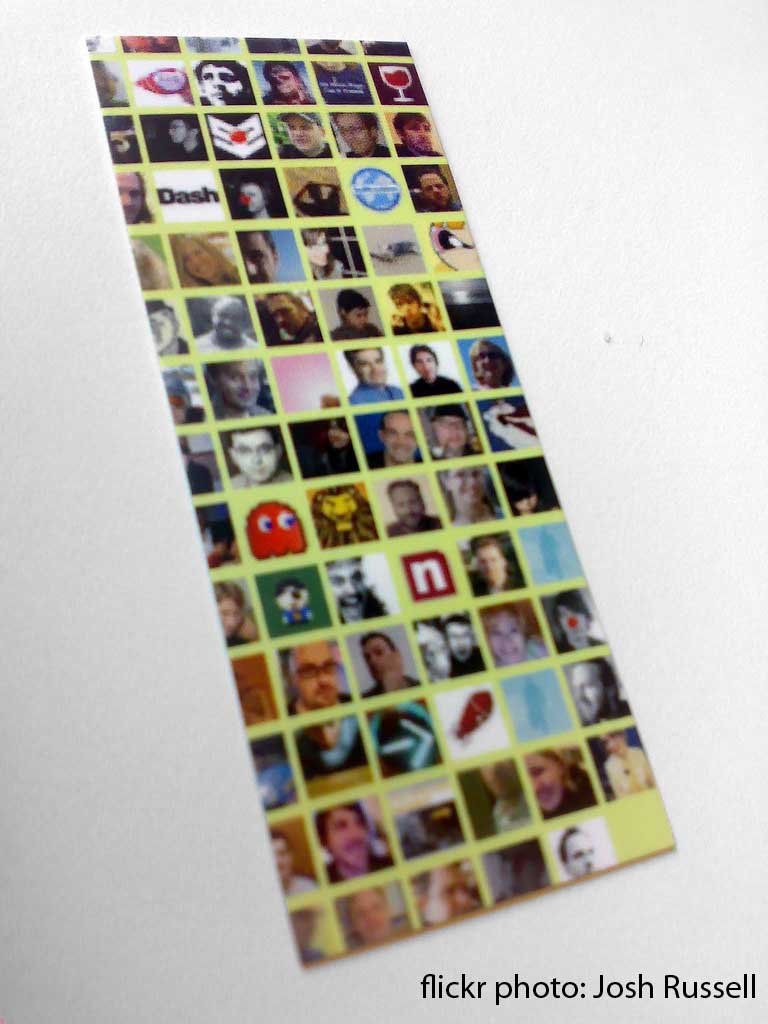 A strange article came out a bit ago, about how the engagement with Twitter is much lower than we believe. The strange thing is that they are basing it on the measured number of Responses and Retweets. Who knew that was the primary objective of Twitter? Not the designers of Brizzly or TweetDeck, two of the primary interfaces for “engaging” with Twitter.
A strange article came out a bit ago, about how the engagement with Twitter is much lower than we believe. The strange thing is that they are basing it on the measured number of Responses and Retweets. Who knew that was the primary objective of Twitter? Not the designers of Brizzly or TweetDeck, two of the primary interfaces for “engaging” with Twitter.
If ReTweeting is the way of showing engagement on Twitter (a big “if” because many of us just enjoy reading the Tweets) then the interfaces should be designed to encourage that. It would be simple to make ReTweeting more simple than any other interaction on the site/app. And I think that a few changes to the design could cause ReTweets to go up.
The fact is, Twitter is a very new way of communicating with people/friends/admirers/stalkers and people need some nudging toward how to make the most of it. Interfaces can do that, easily. But most of the services for Twitter focus on Tweeting and reading. So that’s what people do.
I do suspect that a primary reason that RT is a primary measure of engagement, is because it’s much easier to measure than time spent reading. Or level of enjoyment when interacting. The disappointing thing is that many programs do keep track of the tweets you’ve seen, so with some creative data analytics, they could tell us how much time people spend, and how many tweets are seen. Do you think TweetDeck has user researchers who will be presenting this kind of info at CHI? Hope so!
In the Carnegie Mellon Design program we were taught that Designers are experts in process, rather than topics. The pride of a CMU designer is that we can design “anything.” That works pretty well if you work in a consultancy, where everyone is expected to switch topics every few months, and enjoy it.
But when you work in-house, the expectations for your domain knowledge are much higher. I work for an internet company, and it is natural for people to expect me to know a great deal about technology. But I don’t. I know a great deal about people and how they behave and how they express themselves. And I know how to learn more about that. And I know how to get people to share their thoughts with me in a way that answers questions that are very difficult to answer.
But it erodes my credibility when I don’t know the latest TechCrunch opinion. So, of course, I try to read more blogs and articles. I try to use the latest apps and services. I have a twitter account: hillarydesres.
But in reality, I’m never going to spend all of my free time keeping up on the latest technology. But I’ve realized that through consistent collaboration with teammates, I learn far more than I would on my own. When I need to know the latest technology– or the latest anthropological theories– I know who to ask. I think of it as outsourcing my knowledge. I have all the knowledge I need– I just keep it stored in other people’s brains.
After working for several years at a design and innovation firm, I’d grown to rely on Designers for creative problem solving… sort of thinking of myself as the person who leads the framing of the interesting, relevant questions and Designers as the ones who lead the elegant solution-finding. But in my new position I’ve been without Designers on my team. But because I position myself as a Design Researcher, I wanted to deliver insights that had solutions, at least the beginning of solutions, attached to them.
That’s when I realized that this was a chance to rely on the kindness of teammates. And they’d probably enjoy it along the way. I turned each of my findings presentations into brainstorming sessions– presenting compelling user stories alongside opportunity areas. I asked questions like “Imagine that 10 years from now we are wildly successful as _______. What would that experience be like?” And asked engineers, product and marketing managers to grab a sharpie and some half-sheets of paper and tell me what I didn’t already know.
It has been a great way to understand what my brilliant teammates know about the opportunity areas– and they have diverse perspectives. It’s also been a great way to learn what is most surprising and inspiring to the teams. Some insights they nod their heads, sometimes they even say, “we’re already working on that.” But other insights spark great conversations, light bulbs pop up around the room. Those are the topics I dig deeper into.
The best part is that I did this before delivering my final report. So now, as I craft that massive presentation, I know what my stakeholders care about. I know more about it than I did before. And I have funny little sketches to illustrate many of the important points.
My experience with tough decisions in cross-functional groups is that no one will listen to you, unless they know you have heard them.
When you walk into a room believing that you already understand all of the issues, and you’re ready to move forward, you are not going to be able to without taking the time to hear the opinions in the room.
I have been focusing more on using research to inspire and influence strategy. And when meetings come together to determine something as important as strategy, everyone in the room will have an opinion that needs to be heard. You might as well plan for it. Make time for the stakeholders to share their ideas. When I have time I’ll structure activities around this.
Simple worksheets help frame people’s thinking and get everyone to express their ideas in the same format (and as briefly as possible).
Paired exercises help people share their thoughts and organize them with another person– often finding common ground or places to compromise. Before sharing their priorities with the group.
I have been practicing Design Research for nearly ten years now, in various contexts. And a recent conference hosted by DMI helped me take a critical look at how I can improve my practice.
Roger Martin has contributed foundational work to the conversation of what Design Thinking is and why it is valuable. From his definition I am able to see that Design contributes two distinctly different benefits to problem-solving:
1. A new way of looking at the problem
2. Creative tools for finding solutions
To me, this breaks down into two steps– though for many people these may happen instantaneously. When I think about my own current work, conducting user-centered research to help inform the future of Communications products, I realize that I haven’t been pushing hard enough on the second point. I enjoy the process of developing insights. Insights are compelling and exciting, and it’s rewarding to read between the lines and discover new opportunities. But to fully participate in Design Thinking, I need to deliver insights together with possible solutions.
In my current project, I am not partnered with a Designer to help me find creative solutions. I choose not to look at this as a barrier, but as an opportunity to engage others in my mission to find new solutions. I see now, after listening to a series of Design Thinkers at the “Re-Thinking Design” conference, that I need to turn my glossy presentation of exciting insights into a working session that engages different teams in helping me to shape the final part of my presentation– together we can propose solutions that make the insights more compelling and real.
In the earliest phases of innovation, the time when you are open to discovering something new, is when the most rewarding conversations can happen. I begin this phase of research with a moderator guide, question after open-ended question organized into potential themes. But I rarely follow them. In the first few interviews I’m surprised if I use 3 of those questions in the interview.
When you are seeking inspiration from users. From what people really care about, what they are really frustrated by. When you are open to building ANYTHING that would fulfill a real user need… then the conversation begins with a single question, and there is no telling where it will go from there.
I often begin with something incredibly open ended, “How was your day?” and the conversation evolves from there.
In the middle of a wonderful week of rich conversations about how people communicate, I listened to a Studio360 podcast about the latest installation at the Guggenheim. I was so moved. It is a brilliant and touching piece of experiential art. Listen to it here:
http://www.studio360.org/episodes/2010/02/26
or this excerpt from the Slamxhype blog:
Presented as part of the Guggenheim’s 50th Anniversary celebrations, Sehgal’s exhibition comprises a mise-en-scène that occupies the entire Frank Lloyd Wright–designed rotunda. In dialogue with Wright’s all-encompassing aesthetic, Sehgal fills the rotunda floor and the spiraling ramps with two major works that encapsulate the poles of his practice: conversational and choreographic. To create the context for the exhibition, the entire Guggenheim rotunda is cleared of art objects for the first time in the museum’s history.
Tino Sehgal is made possible by the International Director’s Council of the Solomon R. Guggenheim Museum. Additional funding is provided by the Institut für Auslandsbeziehungen, the Juliet Lea Hillman Simonds Foundation, and the Consulate General of the Federal Republic of Germany. The Leadership Committee for Tino Sehgal is gratefully acknowledged.
Prototype testing at a large scale requires a careful choice of words.
Let’s work backwards:
Implementation: contains the assumption that the set of concepts has been tested and proven and is worth committing to at full-scale.
Piloting: The set of concepts has been developed, tested in small parts, and is now ready to be tested at full scale.
Field Testing: The pieces are ready to be tested in context. Participants will use parts, some in combination, but the ideas are still being developed.
Prototype Testing: Each individual part will be developed, refined and used in small tests.
These are all terms that refer to testing ideas in context. There may be some usability testing, or other types of tests that happen before bringing the ideas into context.


